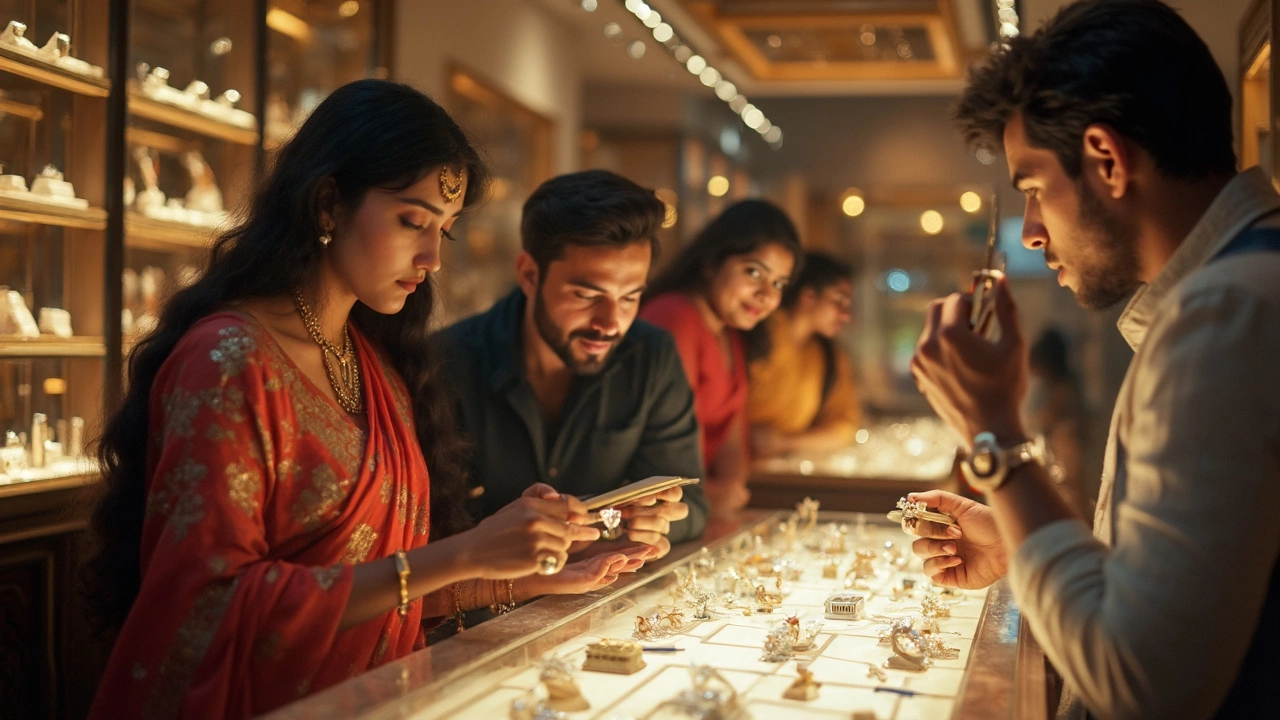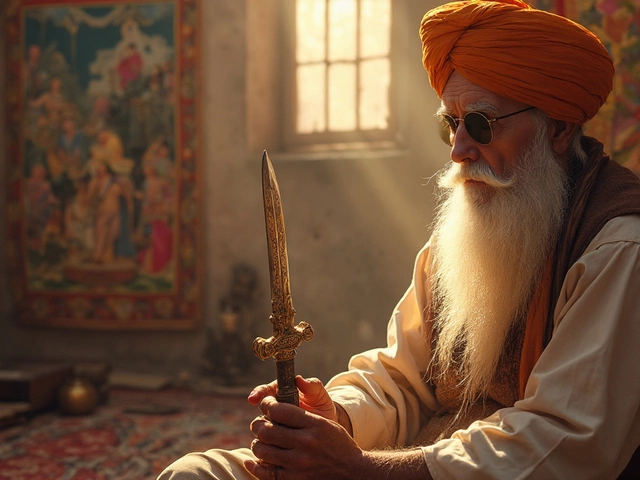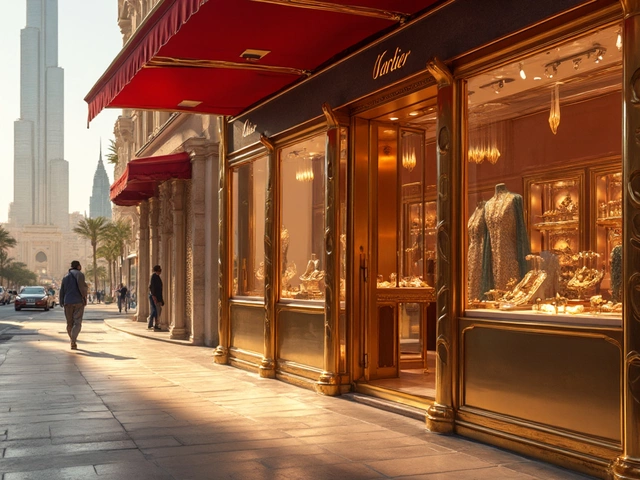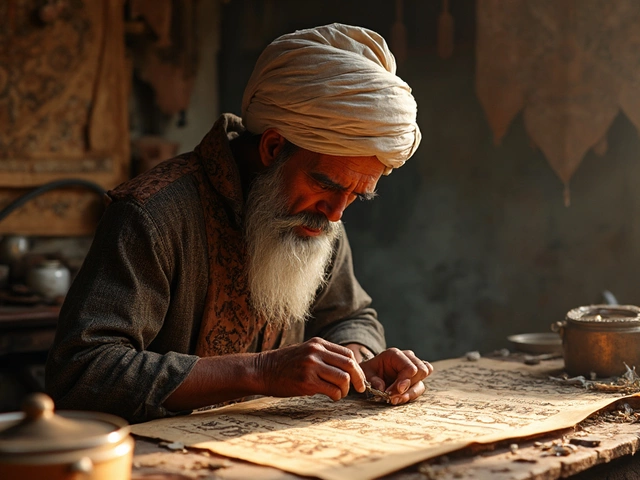If you’ve ever shopped for a diamond ring in India, odds are you’ve wondered: Are these diamonds actually real? It sounds simple, but the answer has a few layers. India is one of the biggest hubs for cutting, polishing, and selling diamonds. Walk through Mumbai’s Zaveri Bazaar or browse diamond stores online, and you’ll be hit with everything from jaw-dropping solitaires to budget rings with a sparkling “diamond look.”
Here’s the thing—real diamonds are everywhere in India, but so are fakes and imitations. Lab-grown diamonds, cubic zirconia, American diamonds (which, fun fact, aren't even diamonds)—they all sit in glass counters right next to the real stuff. Spotting the difference isn’t always easy unless you know what you’re looking at.
Most genuine diamond rings in India come with a certificate from top labs like IGI, GIA, or SGL. If someone hesitates to show one, that’s an instant red flag. Still, some sellers bank on buyers not asking questions. Save yourself some trouble: always ask to see the paperwork before you fall for the sparkle.
- How Big is India’s Diamond Market?
- What Makes a Diamond ‘Real’?
- How Indians Buy and Sell Diamonds
- Spotting Real vs. Fake Diamonds in India
- Certifications and Where They Matter
- Tips for Safe Buying: What Locals Know
How Big is India’s Diamond Market?
If you've ever heard someone say India is the heart of the diamond industry, they're not kidding. India is the world's biggest diamond cutting and polishing center—about 90% of all diamonds sold around the globe have spent some time in an Indian workshop. Even those fancy stones you see in New York, London, or Dubai? Chances are, they got their sparkle in Surat, not at their final destination.
| Fact | Value |
|---|---|
| Global share in cutting and polishing | Around 90% |
| Diamond exports (2023-24) | ~$23 billion |
| Key hub | Surat, Gujarat |
| Employment | ~1 million people |
Surat, a city in Gujarat, sets the gold standard (well, diamond standard) when it comes to cutting and polishing. Families have worked in this trade for decades. Some of the smallest stones—think below half a carat—are cut by hand, without any fancy machines. That attention to detail built up India's reputation as the go-to place for finished diamonds.
When it comes to diamond rings—or just diamond rings India—you'll find every type from budget buys to super-luxe. Big brands and small shops alike source their stones locally thanks to deep supply chains.
According to the Gem & Jewellery Export Promotion Council:
"Nearly 14 out of every 15 diamonds in the world are processed in India. The country is not just a hub for labor, but for craftsmanship and trading power."
This isn’t just about export. In recent years, more and more real diamonds India are being sold within the country too. As middle-class buyers grow, local jewelry demand is booming. You'll find retail stores from Tata's Tanishq to independent stores in every big city touting certified stones for engagement rings and wedding bands.
So, if you’re shopping for diamonds here or anywhere else, there’s a good chance your bling has an Indian connection—if not in the shop, then before it ever made it to market.
What Makes a Diamond ‘Real’?
If you’re eyeing a sparkling rock and wondering if it’s a real diamond, there’s actually a simple answer: a diamond is only 'real' if it’s formed from carbon under high pressure and temperature—just like the ones pulled out of the earth. These are called natural diamonds. You’ll also hear about lab-grown diamonds, which look exactly the same, because they’re created in a lab using tech that mimics those extreme natural conditions. For both, the material is pure carbon in a particular crystal structure, and honestly, you’d need some serious equipment to spot the difference.
But here’s where things get confusing in the diamond rings India business. Some sellers stick anything shiny in a ring and call it a diamond. Cubic zirconia, moissanite, 'American diamonds,' and a dozen other imposters crowd the market. They might look convincing to the naked eye, but they’re chemically different and nowhere near as valuable.
If you want to be sure you’re holding a real diamond, these are the big things to look for:
- Material: Only real diamonds (natural and lab-grown) are made of pure crystallized carbon.
- Hardness: Diamonds are the hardest natural material on earth—rated 10 on the Mohs scale. None of the fakes come close.
- Light Reflection: Real diamonds return light in a way that gives those sharp, almost blinding sparkles, called “brilliance.” Fakes usually look more glassy or give off rainbow colors that look a bit fake when you know what to watch for.
- Certification: A legit diamond ring in India should come with a grading report from recognized labs like GIA, IGI, or SGL.
Here’s a quick look at how common imitations stack up against real diamonds:
| Material | Hardness (Mohs) | Price |
|---|---|---|
| Natural Diamond | 10 | High |
| Lab-Grown Diamond | 10 | Medium-High |
| Cubic Zirconia | 8-8.5 | Low |
| Moissanite | 9.25 | Medium |
The bottom line: if you want the real deal, stick with certified real diamonds India, whether natural or lab-grown. Fakes might be shiny, but they just don’t have the same value or meaning.
How Indians Buy and Sell Diamonds
When people think about diamond rings in India, they picture everything from small neighborhood jewelers to massive branded stores lining city streets. India’s diamond business is a mix of old-school family trading and new-age showrooms. It’s actually kind of wild—about 90% of the world’s diamonds are cut and polished right in India, mostly in Gujarat. Surat alone is a diamond capital; if you meet someone from there, chances are, they know a cutter or seller.
Buying diamonds in India often means sitting across the counter from someone who’s been in the trade for generations. Families pass down the business, and with that comes a certain street wisdom for both sellers and buyers. Haggling isn’t just allowed—it’s expected, even in big stores.
It’s pretty common for buyers to:
- Visit several shops before settling on a diamond ring (even for engagement rings).
- Ask to see different sizes and qualities for the same budget.
- Compare certificates from labs like GIA and IGI to make sure diamonds are authentic.
- Negotiate making charges, which is the jeweler’s extra fee for crafting the ring.
If you’re selling a diamond in India, expect the jeweler to check it with a loupe (the tiny magnifying glass), test it under UV, and review its certificate. The resale value depends a lot on the diamond’s cut, clarity, and most importantly, original certification. Diamonds without papers just don’t fetch much.
Here’s a quick look at how the Indian diamond market really works:
| Aspect | Details |
|---|---|
| Major Hubs | Mumbai, Surat, Jaipur |
| Key Buyers | Weddings, investments, gifts |
| Preferred Certification | GIA, IGI, SGL |
| Typical Markup | 10-25% over wholesale |
| Common Alternatives | Lab-grown, cubic zirconia |
If you’re shopping for real diamond rings in India, go to stores with a good local reputation and always ask for a certificate. If you’re selling, bring the paperwork and be clear on expected resale value. No shortcuts here—documentation is everything.
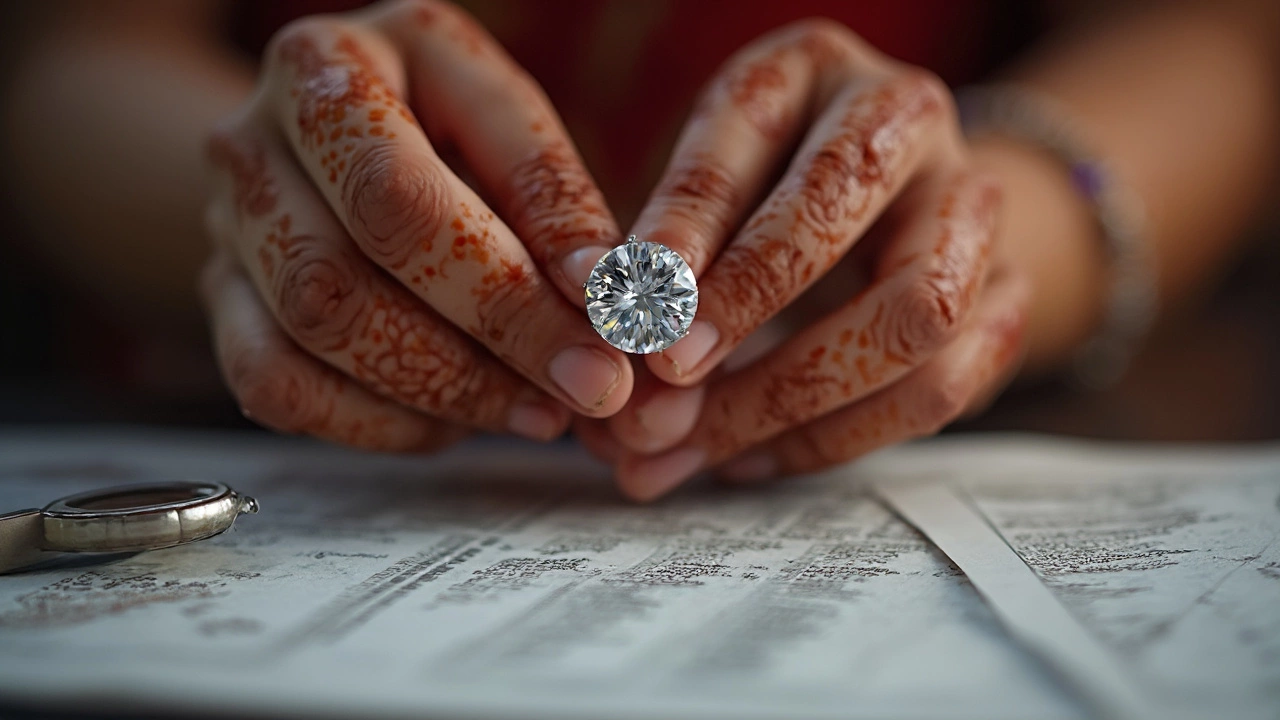
Spotting Real vs. Fake Diamonds in India
Think every shiny stone in the shop window is a real diamond? Not even close. In India, you’ll find natural mined diamonds, lab-grown diamonds, and imitations like cubic zirconia and glass—all being sold side by side. Sellers might even give them local names like “American diamond” to sound fancy, but that’s just code for ‘not a real diamond.’
The good news? There are some dead-simple tricks to tell if you’re dealing with real diamonds India shoppers trust, instead of a fake.
- Check for Certificates: Real diamond rings India buyers should always have proper certification. Major labs include GIA, IGI, or SGL. If the seller dodges when you ask about this, walk away.
- The Fog Test: Breathe on the diamond. A real one won’t fog up much; a fake will stay misty for a few seconds.
- Use a Loupe: Even a cheap jeweler’s loupe can show you the tiny flaws found in natural diamonds. Most fakes look way too perfect up close.
- Water Test: Real diamonds have high density, so if you gently drop one in water, it’ll sink. Fakes will usually float or sink much slower.
- Look for Laser Inscriptions: Many real diamonds, especially those above 0.3 carats, will have a microscopic inscription on the girdle that matches their certificate.
If you’re serious about your purchase, you can also hit up a professional appraiser. Jewelers usually charge a small fee, but you’ll get a straight answer on whether what you’re holding is genuine. Fun fact—India processes over 90% of the world's cut diamonds, so it's easy to find both real and fake stones on the market.
| Test | Real Diamond Result | Fake Result |
|---|---|---|
| Fog/Breath Test | Minimal fog, clears fast | Stays foggy for seconds |
| Loupe Test | Small natural flaws | Too perfect or glassy |
| Water Test | Sinks quickly | Floats or sinks slowly |
| Certification | GIA/IGI/SGL certificate | No docs, generic claim |
Just remember, if the deal feels too good to be true, it probably is. Whether you're browsing posh boutiques or small shops, stick to these checks before you drop your hard-earned money on a diamond.
Certifications and Where They Matter
If you're serious about buying real diamonds in India, you need to understand certifications. Not all sparkling stones are the real deal, and those certificates aren't just papers—they're proof your diamond is what the shop claims.
The most trusted labs in India are GIA (Gemological Institute of America), IGI (International Gemological Institute), and SGL (Solitaire Gemmological Laboratories). Ask any jeweler worth their salt, and they'll show you one of these names. Here's why they matter:
- GIA is famous worldwide for tough standards—if your diamond passes their tests, it's definitely legit.
- IGI is super common in India and Europe and gives you solid, detailed reports on both natural and lab-grown diamonds.
- SGL is picking up in popularity, especially in major Indian cities, and is trusted for quick verifications by retailers.
Diamonds with these certificates are easier to resell, too. Try selling a ring without GIA, IGI, or SGL credentials, and you'll quickly learn Indian pawnshops and big jewelers don’t take your word for it. They want to see the actual report before trusting the value of your diamond ring.
According to GIA standards, a real diamond certificate should mention:
- The diamond's cut, clarity, color, and carat (the famous 4Cs)
- If it's natural or lab-grown
- Laser inscription number, if available
- Details about any treatments
Check out this quote from GIA itself:
“A GIA report means that your diamond was evaluated independently by the world’s premier gem laboratory. This gives you a reliable assessment of the diamond’s quality and authenticity.” – GIA
Want the nitty-gritty? Here's a comparison of the three most common labs in India:
| Lab | Trusted in India? | Checks for Lab-Grown? | Recognized Worldwide? |
|---|---|---|---|
| GIA | Yes | Yes | Yes |
| IGI | Yes | Yes | Yes |
| SGL | Yes (mostly urban) | Yes | Getting There |
If a seller tries pushing a diamond without any of these certifications, or with something that looks like a home-printed certificate, it's not worth the risk. Insist on the paperwork. Your wallet and peace of mind will thank you.
Tips for Safe Buying: What Locals Know
Buying real diamonds in India is totally doable if you use some street smarts. Locals rarely just walk into a shop and make a big purchase on a whim—they do their homework first. Here’s how they keep from getting ripped off.
- Go to Established Stores: No one in their right mind bets big money at a tiny kiosk in a corner market. Locals trust stores with a solid reputation—those stores don’t want any trouble, and they count on repeat business. Ask friends for recommendations or look up store ratings online before you walk in.
- Always Ask for Certification: Any reputable jeweler in the diamond rings India market must give you a diamond certificate, usually from IGI, GIA, or SGL. If they hesitate or try to dodge the request, walk out. No certification? Don’t buy, no matter how nice the piece looks.
- Check the Buy-Back Policy: Most big stores offer a buy-back or exchange policy on Indian diamonds. This policy is a hidden clue—if a store is legit, they have no problem promising to buy back at a fair price. If they don’t offer this, or it sounds sketchy, be careful.
- Understand the Pricing: The price of diamond rings in India depends on the "4 Cs" (cut, clarity, color, carat) and the current market rate. Don’t fall for “special discounts”—if the price seems too good, the product is probably too bad.
- Get a Bill with All Details: Ask for an invoice that clearly lists everything—weight, carat, gold quality, and making charges. This acts as your proof if you ever need to resell or complain.
Here’s a quick snapshot locals rely on when sizing up a shop’s reliability:
| What to Check | Good Sign | Red Flag |
|---|---|---|
| Certification Provided | IGI, GIA, SGL | Homemade certificates or none |
| Transparent Pricing | Breakdown of 4 Cs, tax, and charges | Lumped prices, unclear components |
| Buy-Back/Exchange Policy | Clearly offered, written down | Vague promises or none |
Locals also use their phones: they’ll Google the diamond authenticity certificate number right in the shop or even weigh and test the stone in front of the seller. If the seller objects, that’s usually enough reason to leave. It doesn’t have to be stressful—just stay sharp and use these tips, and you’ll find that buying genuine diamonds in India is more about common sense than crystal balls.
